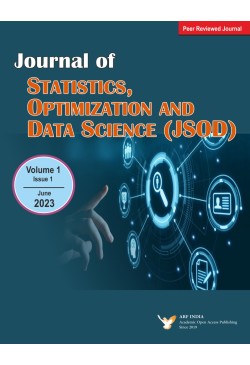JSODSJournal of Statistics, Optimization and Data Science

Peer Reviewed Journal

Peer Reviewed Journal
Application of the ARIMA model in forecasting Vietnam’s monthly import turnover of medium oils and preparations, of petroleum or bituminous minerals, not containing biodiesel, from China
The energy sector is pivotal in fulfilling a nation’s energy requirements and facilitating economic and social development. In Vietnam, the oil and gas industry has demonstrated remarkable growth, consistently ranking second in energy production, trailing only coal. By 2023, Vietnam’s total extraction of oil and condensate surpassed 424 million tons, while gas production exceeded 160 billion cubic meters. At certain points, this sector has contributed nearly 30% to the state budget and between 22% and 25% to the nation’s GDP. It is estimated that Vietnam maintains a self-sufficiency rate of approximately 13 million tons of oil annually, meeting 65-70%
of domestic demand. However, the increasing consumption of oil and gas coupled with a gradual decline in production signals potential future supply challenges, suggesting that Vietnam may need to rely entirely on imports. Notably, China has emerged as a primary supplier of medium oil and crude oil derivatives, with import volumes from this market rising steadily and currently ranking second only to Brazil. Therefore, analyzing and forecasting the import turnover of medium oils and preparations, of petroleum or bituminous minerals, not containing biodiesel, from China play a crucial role in understanding the developments in Vietnam’s oil and gas sector in the coming years. This study employs the Box-Jenkins methodology to construct an ARIMA model aimed at forecasting the import volumes of medium oil and crude oil products, excluding biodiesel, from China to Vietnam, utilizing monthly data sourced from ITC (International Trade Center). The results indicate that the ARMA(p,q) with p = 1 and q = 2, 3, 5, 6, 8 model is the most suitable among the various models considered. Furthermore, the study provides short-term forecasts for imports classified under HS code 271019. However, it is important to note that the current model exhibits limitations in its forecasting capabilities and has not been fully optimized, as its reliance on linearity may oversimplify the complexities inherent in the data. This underscores the need for more sophisticated modeling techniques in future research.
KEYWORDS: ARMA, Forecasting, Medium Oils Import Volume, Data Science.
Distance Rank Score: unsupervised filter method for feature selection on imbalanced dataset
This paper presents a new filter method for unsupervised feature selection. This method is particularly effective on imbalanced multi-class dataset, as in case of clusters of different anomaly types. Existing methods usually involve the variance of the features, which is not suitable when the different types of observations are not represented equally. Our method, based on Spearman’s Rank Correlation between distances on the observations and on feature values, avoids this drawback. The performance of the method is measured on several clustering problems and is compared with existing filter methods suitable for unsupervised data. It is shown that Distance Rank outperforms or is competitive with the other methods on the use cases simulating anomaly detection problems. Moreover, the explainability of the method is reinforced compared to other methods since only a few relevant features are needed to achieve a good performance.
KEYWORDS: unsupervised feature selection, dimension reduction, imbalanced classes